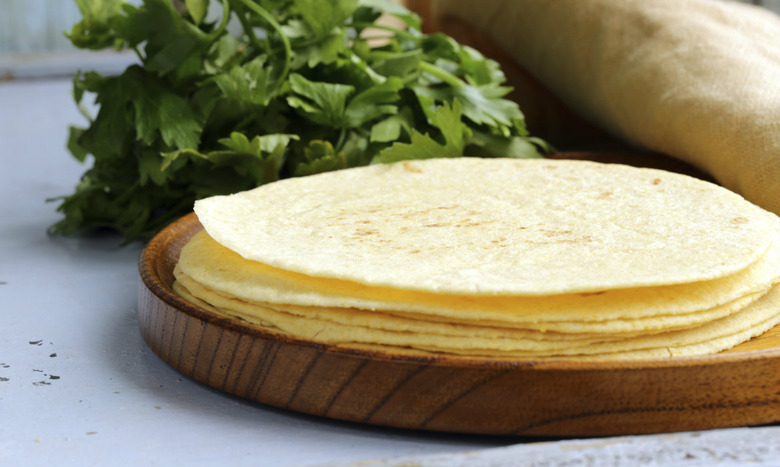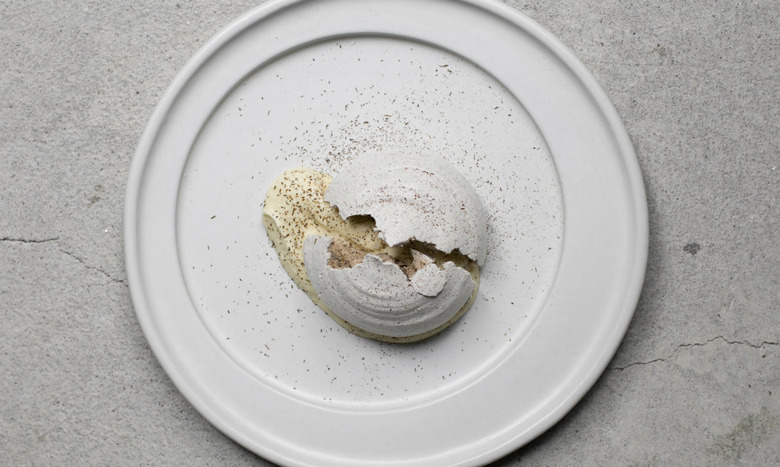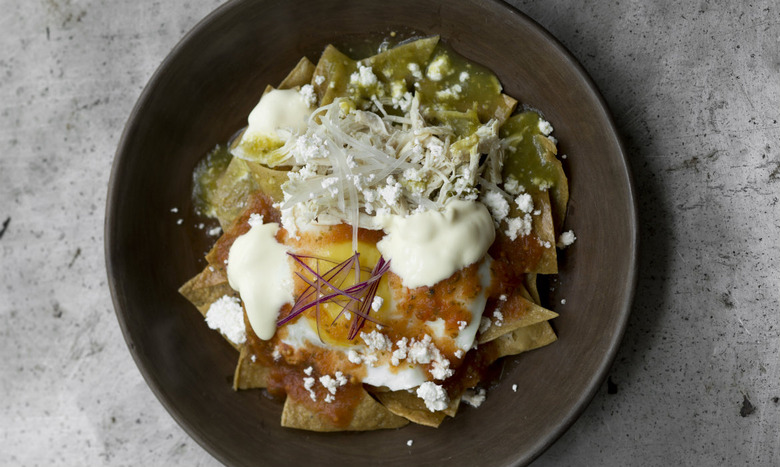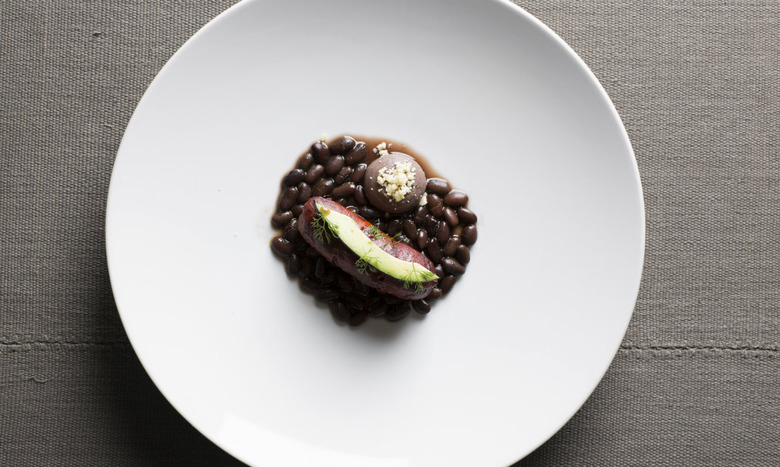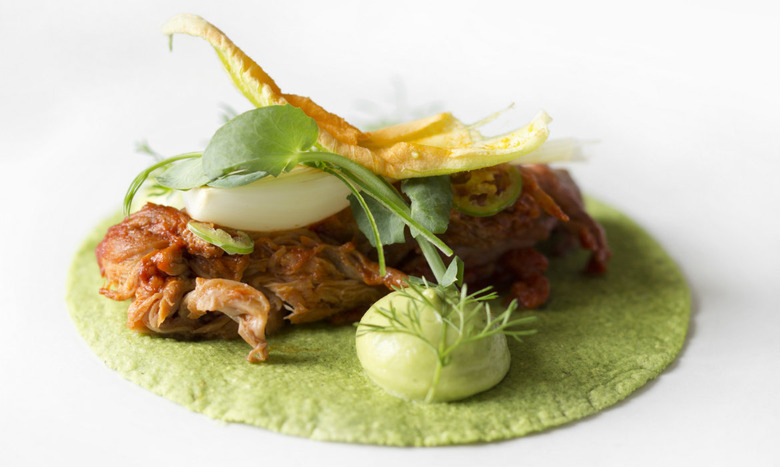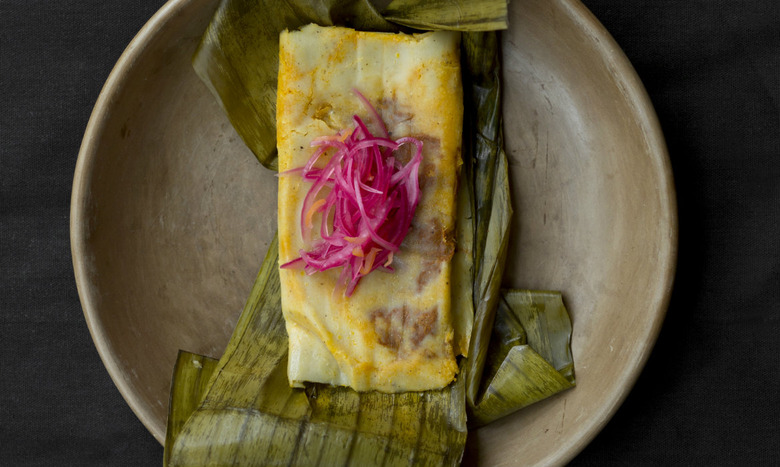Mexican Gastronomy In 'Mexico From The Inside Out'
"Mexican food can be taunting (some ingredients fight each other like the eagle and serpent in our coat of arms), but it can also be a reconciliation between rivals," says Enrique Olvera in the introduction to his debut cookbook, Mexico from the Inside Out. "The Best Chef in Mexico," may be a title that Olvera uneasily accepts, but his success opening first Pujol, in Mexico City more than 15 years ago, and now Cosme, in New York City this past year, prove that his vision for the direction he sees Mexican cuisine heading is steadfast.
Olvera brings a trained eye to everyday dishes like tamales and tacos that are otherwise considered common, but under his skilled direction combine highly trained technique and powerful flavors to make you rethink everything you thought you knew about Mexican food.
Olvera's cookbook is a reflection of the food he serves in his flagship restaurant in Mexico City, and while the techniques are at times challenging, he breaks down each step for the ambitious home cook to successfully tackle.
If you aren't interested in working with some of the more challenging techniques described in this book, which includes the use of a sous vide machine, then use this collection of beautifully photographed dishes and thoughtfully curated head notes to learn more about a cuisine that is more than the two-for-one margarita happy hour at your local kitschy Mexican knock-off restaurant would lead you to believe.
Olvera's efforts to turn his attention inwards to his native country and push the conversation of Mexican gastronomy is heard, seen, and if you're lucky, tasted through this cookbook.
We had the opportunity to talk with Olvera and find out more about his food, flavors, and inspiration.
The Daily Meal: What is your general philosophy on cooking?
Enrique Olvera: Change and dynamism.
How did that inspire the recipes included in this book?
I was interested in showing how steady change has influenced and established our kitchen. At Pujol, we are constantly learning and transforming ourselves, which leads us to continually improve our methods and cuisine. In the process of creating the book, there was a chance to be reflective and see the evolution of our cooking over the 15 years we've had Pujol.
What other influences specifically did you pull from when you began to reinterpret traditional Mexican cuisine at your restaurant Pujol?
When I was at the CIA, I learned mostly according to French cooking parameters and traditions. I came back to Mexico having mastered those techniques but barely knew anything about my own country's gastronomy. When I first opened Pujol, it wasn't successful and I didn't know why.
At a certain point, I realized the mistakes I was making at the restaurant and assumed a responsibility that was owed to my country and culture. I stopped looking outside and turned inside.
I knew technique and sophistication were important, as I learned at the CIA, but I needed to approach food differently. Using my grandmother's cooking as an influence, I shifted gears and cultivated traditional Mexican recipes. My past experiences were integrated into the cooking at Pujol and we became successful by elevating Mexican cuisine. I learned that I had to be myself.
You've said street food is an influence. How is that influence translated to the plates of your refined dishes?
Flavor. The most amazing thing about Mexico is flavor and its power, and authenticity overrides my cooking. My main task is to interpret these diverse, complex, and unique flavors into my own language and then present them in a fine dining setting.
I strive to put a little bit of order into the chaos into my food. I harmonize opposites — confront the past and the present, the local and global.
What was the process of collecting, selecting, and writing down the recipes in this book? What different sort of things did you consider when picking your final collection of recipes?
I'm not comfortable with the idea of just one type of cuisine. I like to move from one side to another, from fine dining to casual, from traditional to modern.
When it came to the book and recipes, we came up with a concept that would reflect these dichotomies and created a book with two sides, A and B. Side A features recipes that not only portray our way of seeing, doing and living the cuisine at Pujol but it is also a testament to four special moments and pillars for us during all these years. Therefore, Side A is broken into sections on tradition, the streets, the ground, and the inside. The refined and sophisticated recipes included here allow readers to bear witness to Pujol's constant change and evolution over the years. Side B features informal recipes that I love to share with my family and that anyone can make at home. This side includes dishes that I crave the most when I am not at home in Mexico.
How do you hope readers will use this book?
I hope readers will use this book as an inspiration. I realized we should try not to take things so literally, but to find keys to create our own stuff. That's the secret. Just look inside-out.
What is the ultimate take-away for readers?
This book is a window into our world. We hope that the readers will not only take a look at our philosophy at Pujol, but will also look toward Mexico, with its diversity, chaos, richness, contradiction, and uniqueness.
Want to try a recipe?
Corn Dough chiles
Use this basic corn dough for soft or fried corn tortillas, dumplings, and more. You can also add , spices, and herbs for a flavorful twist.
Corn Husk Meringue and Corn Mousse mousse
This unusual dessert uses corn husks in two ways: in a smooth subtle corn flavored and a crunchy meringue.
For the Corn Husk Meringue and Corn Mousse recipe, click here.
Divorced Chilaquiles salsa
These outstanding chilaquiles from chef Enrique Olvera feature pulled chicken, fried eggs, and two kinds of .
Quail, Chorizo, Bean, and Heirloom Avocado sous vide machine
This recipe for quail cooked in a use all the classic flavors and ingredients found in traditional Mexican cookery, but in a highly refined way.
For the Quail, Chorizo, Bean, and Heirloom Avocado recipe, click here.
Suckling Lamb Barbacoa Taco taco
This lamb barbacoa is made with homemade chile poblano corn tortillas that give it an extra kick of flavor.
Tamaleschicken
Famed chef, Enrique Olvera, gives tamales, a classic Mexican street food an update with fresh herbs, spices, and three delicious fillings: cochinita pibil, green salsa , and goat cheese and red salsa.
